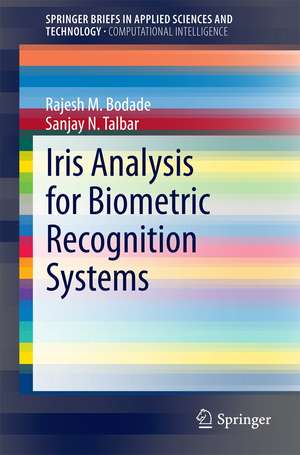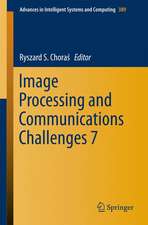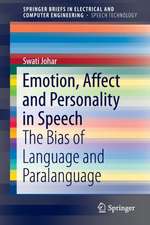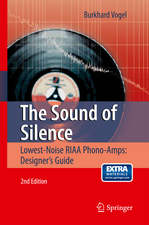Iris Analysis for Biometric Recognition Systems: SpringerBriefs in Applied Sciences and Technology
Autor Rajesh M. Bodade, Sanjay N. Talbaren Limba Engleză Paperback – 21 mai 2014
Din seria SpringerBriefs in Applied Sciences and Technology
-
 Preț: 380.29 lei
Preț: 380.29 lei - 17%
 Preț: 360.34 lei
Preț: 360.34 lei - 20%
 Preț: 386.12 lei
Preț: 386.12 lei -
 Preț: 380.07 lei
Preț: 380.07 lei -
 Preț: 377.95 lei
Preț: 377.95 lei -
 Preț: 382.32 lei
Preț: 382.32 lei -
 Preț: 376.59 lei
Preț: 376.59 lei -
 Preț: 379.09 lei
Preț: 379.09 lei -
 Preț: 378.12 lei
Preț: 378.12 lei - 20%
 Preț: 293.83 lei
Preț: 293.83 lei -
 Preț: 344.90 lei
Preț: 344.90 lei -
 Preț: 321.36 lei
Preț: 321.36 lei -
 Preț: 264.79 lei
Preț: 264.79 lei -
 Preț: 344.90 lei
Preț: 344.90 lei -
 Preț: 356.46 lei
Preț: 356.46 lei -
 Preț: 382.95 lei
Preț: 382.95 lei -
 Preț: 355.66 lei
Preț: 355.66 lei -
 Preț: 479.67 lei
Preț: 479.67 lei -
 Preț: 415.18 lei
Preț: 415.18 lei -
 Preț: 444.52 lei
Preț: 444.52 lei - 20%
 Preț: 301.86 lei
Preț: 301.86 lei -
 Preț: 409.43 lei
Preț: 409.43 lei - 20%
 Preț: 322.17 lei
Preț: 322.17 lei -
 Preț: 355.49 lei
Preț: 355.49 lei - 15%
 Preț: 462.51 lei
Preț: 462.51 lei -
 Preț: 377.18 lei
Preț: 377.18 lei -
 Preț: 355.93 lei
Preț: 355.93 lei -
 Preț: 382.95 lei
Preț: 382.95 lei -
 Preț: 378.12 lei
Preț: 378.12 lei -
 Preț: 378.12 lei
Preț: 378.12 lei -
 Preț: 380.07 lei
Preț: 380.07 lei -
 Preț: 380.07 lei
Preț: 380.07 lei - 20%
 Preț: 326.28 lei
Preț: 326.28 lei -
 Preț: 312.68 lei
Preț: 312.68 lei -
 Preț: 356.43 lei
Preț: 356.43 lei -
 Preț: 412.30 lei
Preț: 412.30 lei - 20%
 Preț: 225.31 lei
Preț: 225.31 lei -
 Preț: 378.12 lei
Preț: 378.12 lei -
 Preț: 376.59 lei
Preț: 376.59 lei -
 Preț: 195.87 lei
Preț: 195.87 lei -
 Preț: 376.22 lei
Preț: 376.22 lei - 20%
 Preț: 324.64 lei
Preț: 324.64 lei - 20%
 Preț: 288.73 lei
Preț: 288.73 lei -
 Preț: 377.57 lei
Preț: 377.57 lei -
 Preț: 261.91 lei
Preț: 261.91 lei -
 Preț: 381.98 lei
Preț: 381.98 lei -
 Preț: 273.64 lei
Preț: 273.64 lei -
 Preț: 410.87 lei
Preț: 410.87 lei -
 Preț: 379.68 lei
Preț: 379.68 lei -
 Preț: 374.30 lei
Preț: 374.30 lei
Preț: 379.48 lei
Nou
Puncte Express: 569
Preț estimativ în valută:
72.62€ • 75.54$ • 59.95£
72.62€ • 75.54$ • 59.95£
Carte tipărită la comandă
Livrare economică 14-28 aprilie
Preluare comenzi: 021 569.72.76
Specificații
ISBN-13: 9788132218524
ISBN-10: 8132218523
Pagini: 132
Ilustrații: XIX, 109 p. 63 illus.
Dimensiuni: 155 x 235 x 7 mm
Greutate: 0.21 kg
Ediția:2014
Editura: Springer India
Colecția Springer
Seriile SpringerBriefs in Applied Sciences and Technology, SpringerBriefs in Computational Intelligence
Locul publicării:New Delhi, India
ISBN-10: 8132218523
Pagini: 132
Ilustrații: XIX, 109 p. 63 illus.
Dimensiuni: 155 x 235 x 7 mm
Greutate: 0.21 kg
Ediția:2014
Editura: Springer India
Colecția Springer
Seriile SpringerBriefs in Applied Sciences and Technology, SpringerBriefs in Computational Intelligence
Locul publicării:New Delhi, India
Public țintă
ResearchCuprins
Introduction to Iris Recognition.- Related Work.- Iris Segmentation.- Iris Recognition using Dual Tree Complex Wavelet Transform and Rotated Complex Wavelet Filters.- Conclusion and Future Scope.
Notă biografică
Rajesh M. Bodade is currently working as Associate Professor in Faculty of Communication Engineering at Military College of Telecommunication Engineering, Mhow, Indore, India. He completed his PhD in Electronics and Telecommunication Engineering (Iris Analysis for Biometric Recognition System) from SRTM University, Nanded, India in 2011. Dr. Bodade has more than 20 years of teaching experience. He received “Chief of Army Staff Medal and Commendation” and “General Officer Command in Chief-Army Training Command Medal and Commendation” on 26 January 2011 and 15 August 2013, respectively, for his outstanding contribution in teaching and research at MCTE, Mhow. He has also published several papers/articles in National and International peer-reviewed journals and Conference Proceedings. He has published over 20 papers in refereed Journals and National/International Conferences of repute. He is the Life member of Indian Society for Technical Education, Institution of Engineers (India) andFellow of IETE. His research interests include signal processing, pattern recognition, biometrics, SDR and cognitive radio.
Sanjay N. Talbar is a Professor in the Department of Electronics and Telecommunication Engineering, Shri Guru Gobind Singhji Institute of Engineering and Technology, Nanded, India. He received B.E. and M.E. degrees from SGGS Institute of Technology, Nanded, India in 1985 and 1990, respectively. He obtained his PhD from SRTM University, Nanded, India in 2000. He received the “Young Scientist Award” by URSI, Italy in 2003. He has published 10 books, 50+ papers in refereed Journals and more than 120 papers in National and International Conferences. He has guided about 70 students for dissertation at M.E./M.Tech. and supervised 10 students for PhD and additional research scholars are working towards their PhD. He is a member of various prestigious academic committees. He is a member of IET (UK), life member of Indian Society for Technical Education (ISTE) and Fellow of IETE. His research interests include image processing, multimedia computing, biometrics and embedded system design.
Sanjay N. Talbar is a Professor in the Department of Electronics and Telecommunication Engineering, Shri Guru Gobind Singhji Institute of Engineering and Technology, Nanded, India. He received B.E. and M.E. degrees from SGGS Institute of Technology, Nanded, India in 1985 and 1990, respectively. He obtained his PhD from SRTM University, Nanded, India in 2000. He received the “Young Scientist Award” by URSI, Italy in 2003. He has published 10 books, 50+ papers in refereed Journals and more than 120 papers in National and International Conferences. He has guided about 70 students for dissertation at M.E./M.Tech. and supervised 10 students for PhD and additional research scholars are working towards their PhD. He is a member of various prestigious academic committees. He is a member of IET (UK), life member of Indian Society for Technical Education (ISTE) and Fellow of IETE. His research interests include image processing, multimedia computing, biometrics and embedded system design.
Textul de pe ultima copertă
The book presents three most significant areas in Biometrics and Pattern Recognition. A step-by-step approach for design and implementation of Dual Tree Complex Wavelet Transform (DTCWT) plus Rotated Complex Wavelet Filters (RCWF) is discussed in detail. In addition to the above, the book provides detailed analysis of iris images and two methods of iris segmentation. It also discusses simplified study of some subspace-based methods and distance measures for iris recognition backed by empirical studies and statistical success verifications.
Caracteristici
Presents conceptual explanation with appropriate suitable figures and supported by empirical studies and statistical success verifications Discusses step-by-step approach for design and implementation of Dual Tree Complex Wavelet Transform (DTCWT) plus Rotated Complex Wavelet Filters (RCWF) Mentions novel approach of iris segmentation which also leads to aliveness detection method Includes supplementary material: sn.pub/extras





















